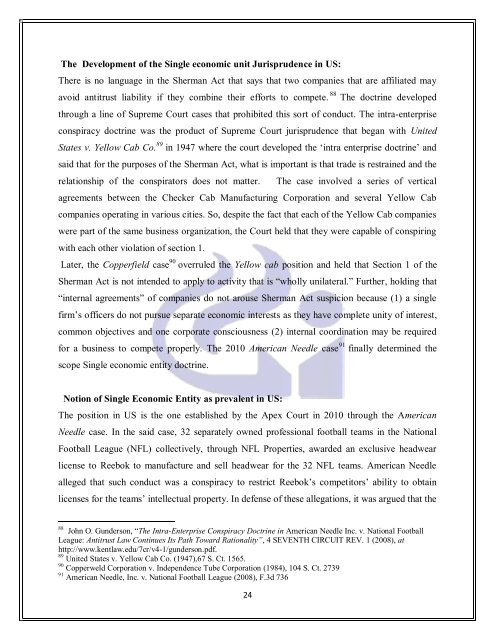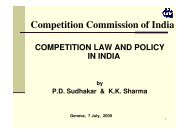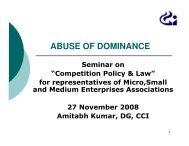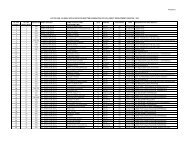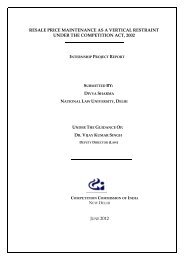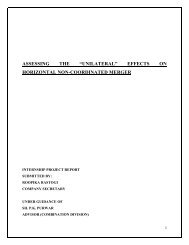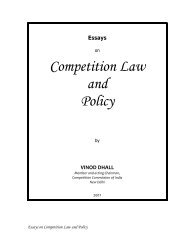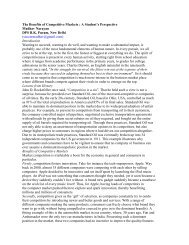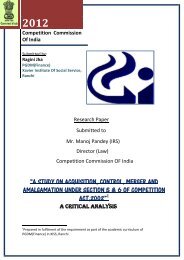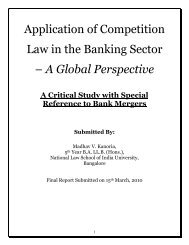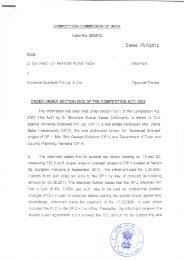applicability of competition law principles on public sector ...
applicability of competition law principles on public sector ...
applicability of competition law principles on public sector ...
You also want an ePaper? Increase the reach of your titles
YUMPU automatically turns print PDFs into web optimized ePapers that Google loves.
The Development <str<strong>on</strong>g>of</str<strong>on</strong>g> the Single ec<strong>on</strong>omic unit Jurisprudence in US:<br />
There is no language in the Sherman Act that says that two companies that are affiliated may<br />
avoid antitrust liability if they combine their efforts to compete. 88 The doctrine developed<br />
through a line <str<strong>on</strong>g>of</str<strong>on</strong>g> Supreme Court cases that prohibited this sort <str<strong>on</strong>g>of</str<strong>on</strong>g> c<strong>on</strong>duct. The intra-enterprise<br />
c<strong>on</strong>spiracy doctrine was the product <str<strong>on</strong>g>of</str<strong>on</strong>g> Supreme Court jurisprudence that began with United<br />
States v. Yellow Cab Co. 89 in 1947 where the court developed the ‘intra enterprise doctrine’ and<br />
said that for the purposes <str<strong>on</strong>g>of</str<strong>on</strong>g> the Sherman Act, what is important is that trade is restrained and the<br />
relati<strong>on</strong>ship <str<strong>on</strong>g>of</str<strong>on</strong>g> the c<strong>on</strong>spirators does not matter. The case involved a series <str<strong>on</strong>g>of</str<strong>on</strong>g> vertical<br />
agreements between the Checker Cab Manufacturing Corporati<strong>on</strong> and several Yellow Cab<br />
companies operating in various cities. So, despite the fact that each <str<strong>on</strong>g>of</str<strong>on</strong>g> the Yellow Cab companies<br />
were part <str<strong>on</strong>g>of</str<strong>on</strong>g> the same business organizati<strong>on</strong>, the Court held that they were capable <str<strong>on</strong>g>of</str<strong>on</strong>g> c<strong>on</strong>spiring<br />
with each other violati<strong>on</strong> <str<strong>on</strong>g>of</str<strong>on</strong>g> secti<strong>on</strong> 1.<br />
Later, the Copperfield case 90 overruled the Yellow cab positi<strong>on</strong> and held that Secti<strong>on</strong> 1 <str<strong>on</strong>g>of</str<strong>on</strong>g> the<br />
Sherman Act is not intended to apply to activity that is “wholly unilateral.” Further, holding that<br />
“internal agreements” <str<strong>on</strong>g>of</str<strong>on</strong>g> companies do not arouse Sherman Act suspici<strong>on</strong> because (1) a single<br />
firm’s <str<strong>on</strong>g>of</str<strong>on</strong>g>ficers do not pursue separate ec<strong>on</strong>omic interests as they have complete unity <str<strong>on</strong>g>of</str<strong>on</strong>g> interest,<br />
comm<strong>on</strong> objectives and <strong>on</strong>e corporate c<strong>on</strong>sciousness (2) internal coordinati<strong>on</strong> may be required<br />
for a business to compete properly. The 2010 American Needle case 91 finally determined the<br />
scope Single ec<strong>on</strong>omic entity doctrine.<br />
Noti<strong>on</strong> <str<strong>on</strong>g>of</str<strong>on</strong>g> Single Ec<strong>on</strong>omic Entity as prevalent in US:<br />
The positi<strong>on</strong> in US is the <strong>on</strong>e established by the Apex Court in 2010 through the American<br />
Needle case. In the said case, 32 separately owned pr<str<strong>on</strong>g>of</str<strong>on</strong>g>essi<strong>on</strong>al football teams in the Nati<strong>on</strong>al<br />
Football League (NFL) collectively, through NFL Properties, awarded an exclusive headwear<br />
license to Reebok to manufacture and sell headwear for the 32 NFL teams. American Needle<br />
alleged that such c<strong>on</strong>duct was a c<strong>on</strong>spiracy to restrict Reebok’s competitors’ ability to obtain<br />
licenses for the teams’ intellectual property. In defense <str<strong>on</strong>g>of</str<strong>on</strong>g> these allegati<strong>on</strong>s, it was argued that the<br />
88 John O. Gunders<strong>on</strong>, “The Intra-Enterprise C<strong>on</strong>spiracy Doctrine in American Needle Inc. v. Nati<strong>on</strong>al Football<br />
League: Antitrust Law C<strong>on</strong>tinues Its Path Toward Rati<strong>on</strong>ality”, 4 SEVENTH CIRCUIT REV. 1 (2008), at<br />
http://www.kent<str<strong>on</strong>g>law</str<strong>on</strong>g>.edu/7cr/v4-1/gunders<strong>on</strong>.pdf.<br />
89 United States v. Yellow Cab Co. (1947),67 S. Ct. 1565.<br />
90 Copperweld Corporati<strong>on</strong> v. Independence Tube Corporati<strong>on</strong> (1984), 104 S. Ct. 2739<br />
91 American Needle, Inc. v. Nati<strong>on</strong>al Football League (2008), F.3d 736<br />
24


